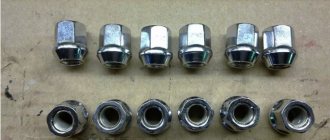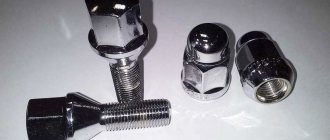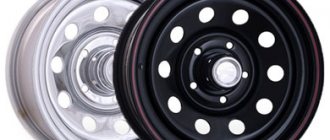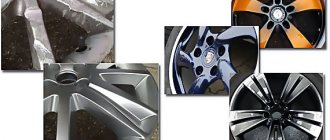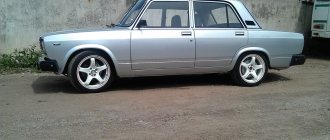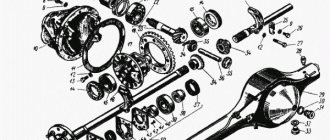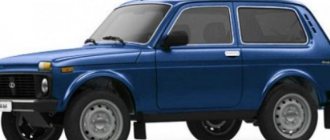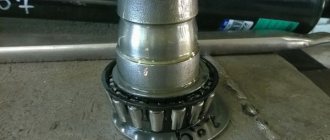Wheel nut Niva Chevrolet size
For the Niva model, the wheel is attached to the hub using wheel nuts. The number of fasteners depends on the year of manufacture of the model and is presented in the table below.
General fastener dimensions:
- number of fasteners: 5 (pcs);
- fastener size: M12x1.25 (mm);
- diameter between fasteners (PCD): 139.7 (mm).
Important: the data presented above are the limits for all vehicle modifications. Specific numbers depend on the year of manufacture.
Rules for selecting wheel fasteners:
It should be taken into account that different wheel fasteners are often used for cast and stamped wheels.
First of all, this concerns the length of the bolts, because... The thickness of different types of discs can vary significantly.
When selecting any fastener, special attention should be paid to the thread pitch. This parameter is always indicated in the marking after the x sign.
For example: the designation M12x1.5 corresponds to a thread with a nominal diameter of 12 (mm) and a thread pitch of 1.5 (mm).
| General parameters of Chevrolet Niva wheel nuts | |||
| Drawing />General view of fasteners | Quantity (pcs) /> Number of fasteners per hub for Chevrolet Niva. | ||
Thread M14 x 1.5 means:
To fasten wheels or disks, 2 main types of fasteners are used:
- wheel bolts; -wheel nuts.
| Size (mm) Metric Fastener Size: | Type Wheel mounting type: | ||
| (drawing of nuts) | 5 pieces) | M12x1.25 (mm) | screw |
| Chevrolet Niva wheel nut size tables | ||||
| Year Model year | Quantity (pcs) Number of fasteners per hub for Chevrolet Niva. | |||
Thread M14 x 1.5 means:
The diameter of the circle on which the mounting holes for Chevrolet Niva are located.
1. The distance between the vertical plane of symmetry of the wheel and the plane of application of the disk to the hub.
Caution: the above data are the official figures of the manufacturer, however, please note that the information is for reference only and does not guarantee absolute accuracy.
A motorist may often be faced with a situation where he needs to install new Niva nuts, the thread size of which is designated as M12x1.25. It would seem that the task is simplest. But wheel nuts are to a great extent responsible for the safety of the driver and passengers, so you can’t just throw them away and put in anything.
Why is it important to know the Niva Chevrolet bolt pattern?
To replace disks, take into account their parameters:
If the last two indicators have established tolerances, then the first ones have very specific indicators.
Wheel rims are attached to the hubs using bolts. The number and distance between them depends on :
- models;
- wheel loads;
- other factors.
The wheels on the car are secured with 5 five bolts located at an equal distance from the center . Bolt pattern is the marking of holes for mounting mounting bolts. Characterized by the diameter of the circle and the number of bolts.
The mounting holes are made with an allowance selected when tightening the bolts . The center of the wheel and the hub are aligned, and if you install disks with distances between the holes that differ by 1-2 mm, this will not be noticeable. However, the wheel will be skewed, and this will cause vibration and wear of the rubber.
Notes by malykh
A short continuation about wheel nuts (see about the difference between nuts for casting and stamping).
A budget option for M12x1.25 wheel nuts are nuts from Niva. Here are two options:
On the left in the photo is a nut from a classic Niva. This is a stamping nut only, not recommended for use with alloy wheels. But on the right is a nut from a Chevrolet Niva. This nut can be used with alloy wheels.
These nuts will also fit the Jimny. Comparison with the original Dzhimnikov nut:
If you suddenly need nuts urgently, and there is an option only for the Sh. Niva, then you can take that too.
3 comments:
I saw the shiny one in the store, the one on the left in the last photo. At least it looks similar. The price is 45 rubles, if I'm not mistaken. Turnkey “for 17” and “for 19”. Actually, this is what I use (both casting and stamping). I have never used the one on the left in the first photo, although it could have happened.
Original Japanese nuts are good, but expensive. And cheap Chinese ones look beautiful, but they can be made from wild “raw meat”. I myself saw how chips were easily removed from such nuts when tightened with stamping (Dotz). :-/ “Shnivovskie” are not ideal, but, in principle, they will do as a last resort at their low price (I recently bought them for 35 rubles apiece). But, of course, you need to take into account the thread (M12x1.25 is not used everywhere).
“The shavings were removed” is, of course, complete chaos. These will go straight to the ferrous metal (if accepted ;-)). But the thread of the studs will not be damaged by the “silumin”. In normal operation I try to adhere to a couple of rules: don’t be lazy to clean the dirt - lubricate the external threads with graphite and do not exceed the tightening torque. Otherwise, ordinary “Russian” nuts (such as “Shniv” ones) will eventually begin to crack when twisted with a wrench. By the way, I like that the “Japanese” type has closed ends. Less negativity on the thread, less fuss.
These will go straight to the ferrous metal (if accepted ;-)). But the thread of the studs will not be damaged by the “silumin”. In normal operation I try to adhere to a couple of rules: don’t be lazy to clean the dirt - lubricate the external threads with graphite and do not exceed the tightening torque. Otherwise, ordinary “Russian” nuts (such as “Shniv” ones) will eventually begin to crack when twisted with a wrench. By the way, I like that the “Japanese” type has closed ends. Less negativity on the thread, less fuss.
2014-08-22
Wheel nuts-2
A short continuation about wheel nuts (see about the difference between nuts for casting and stamping).
A budget option for M12x1.25 wheel nuts are nuts from Niva. Here are two options:
On the left in the photo is a nut from a classic Niva. This is a stamping nut only, not recommended for use with alloy wheels. But on the right is a nut from a Chevrolet Niva. This nut can be used with alloy wheels.
These nuts will also fit the Jimny. Comparison with the original Dzhimnikov nut:
If you suddenly need nuts urgently, and there is an option only for the Sh. Niva, then you can take that too.
3 comments:
I saw the shiny one in the store, the one on the left in the last photo. At least it looks similar. The price is 45 rubles, if I'm not mistaken. Turnkey “for 17” and “for 19”. Actually, this is what I use (both casting and stamping). I have never used the one on the left in the first photo, although it could have happened.
Original Japanese nuts are good, but expensive. And cheap Chinese ones look beautiful, but they can be made from wild “raw meat”. I myself saw how chips were easily removed from such nuts when tightened with stamping (Dotz). :-/ “Shnivovskie” are not ideal, but, in principle, they will do as a last resort at their low price (I recently bought them for 35 rubles apiece). But, of course, you need to take into account the thread (M12x1.25 is not used everywhere).
“The shavings were removed” is, of course, complete chaos. These will go straight to the ferrous metal (if accepted ;-)). But the thread of the studs will not be damaged by the “silumin”.
